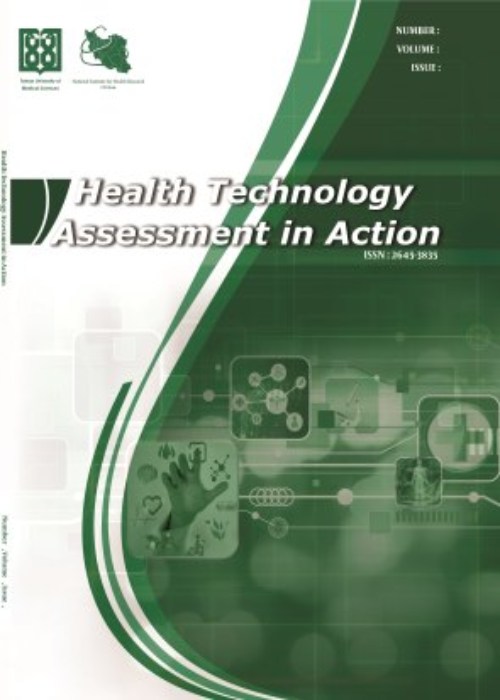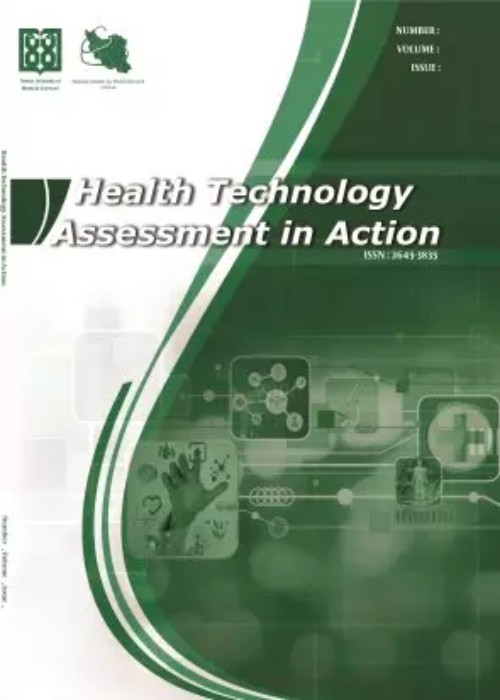فهرست مطالب

Health Technology Assessment in Action
Volume:7 Issue: 2, Dec 2023
- تاریخ انتشار: 1402/07/20
- تعداد عناوین: 5
-
-
Page 1Background
Making a smart and digital supply chain has always been a key phenomenon and a vital factor in organizational transformation. This can play a key role in a country’s health industry. The output can help policymakers check the smart supply chain’s flexibility level and then provide a basis for improving flexibility in the health industry by presenting possible scenarios.
ObjectivesThis study aims to improve the flexibility of the smart supply chain using the system dynamics method by improving intelligence variables.
MethodsThis study used the system dynamics approach and VENSIM DSS to extract and present a dynamic model to investigate and indicate the smart supply chain’s flexibility in Iran’s health industry. The gap between the current and desired situations was identified, and then by implementing possible scenarios, which have been taken from experts’ opinions, steps were taken to improve the supply chain’s flexibility.
ResultsBased on the results, smart supply chain flexibility in Iran is unfavorable and probably faces many problems in providing medicine and health services. Under possible scenarios, the highest level of smart supply chain flexibility in Iran’s health industry relies on the institutionalization of smart warehouses or smart communication by 5% during the period under review. This can increase the average smart supply chain flexibility level to 2.08% and 1.4%, respectively.
ConclusionsAccording to the scenarios, policymakers can provide the groundwork for improving the flexibility of the supply chain of the health industry by changing one of the two variables of smart warehouse and smart communication.
Keywords: Simulation, Smart Supply Chain, Flexibility, Health Industry, System Dynamics -
Page 2Background
The health care sector is a key sector of every country. In the process of economic development, this sector is considered infrastructure since economic development directly affects the productivity of the labor force and, as a result, the increase in production and economic growth. Therefore, the quality of the health care system may be an important factor in attracting foreign direct investment (FDI), accompanied by infrastructure such as labor, education, and research and development costs. As the level of health care increases in a society, the average life expectancy increases as well. Therefore, the life expectancy index (LEI) is an indicator for measuring the progress or backwardness of countries, and thus, it is necessary to examine the factors affecting it.
ObjectivesThis study examined the effect of FDI on the LEI in Iran.
MethodsThe autoregressive distributed lags (ARDL) method was applied from 1981 to 2020, given the time series nature of the data and to test the research hypotheses. The method shows a capacity to be applied to I(0) and I(1) data simultaneously. the following regression model estimation was utilized to investigate the effect of FDI on LEI in Iran: HIt = c0 + c1 gross domestic product (GDP)t + c2 FDIt + c3 literacy rate (LR)t + c4 human immunodeficiency virus (HIV)t + c5 Urbent + c6 real exchange rate (EXR)t + c7 inflation rate (INF)t + c8 interest rate (IR)t + et.
ResultsThe outcomes indicated that FDI has favorable and substantial impacts on the health expenditure variable in Iran over short and extended periods. As a result, it can be anticipated that investing in the health care industry should influence society’s economic advancement. Consequently, FDI becomes a significant macroeconomic factor in health care, acting as an extra investment source. With proper strategies, it holds the potential to serve as a crucial tool for the country’s progress, especially in enhancing the health care sector. The results demonstrated that FDI has constructive and notable effects on enhancing the LEI in Iran, both in the immediate and prolonged durations.
ConclusionsGenerally, the effects of FDI on health care can be described by direct and indirect channels. From the direct channel, FDI may affect health care outputs directly and indirectly, e.g., by providing a wider range of medical supplies and services (such as drugs and medical equipment), the expansion of FDI in the health care sector, and the presence of foreign firms producing medical or health care products that makes the supplies and services available at lower prices and consequently improves health care. From the indirect channel, FDI may influence the health care status of individuals in society indirectly by affecting other variables. Overall, based on the findings, life expectancy is likely to be improved in Iran by attracting more foreign investments in the health care sector.
Keywords: Life Expectancy Index, Health Care Sector, Foreign Direct Investment -
Page 3
Medical devices and biomaterials play pivotal roles in the provision of healthcare and advancements in medicine. Zimbabwe, a low-income country in Southern Africa, faces resource constraints while combating both communicable and non-communicable diseases, which significantly contribute to the nation’s disease burden. The lack of a medical device and biomaterials manufacturing industry in Zimbabwe is a critical issue with profound implications for the country’s healthcare system and economic development. This literature review comprehensively examines the current state of medical device and biomaterials manufacturing in Zimbabwe, focusing on historical perspectives, health infrastructure, challenges, and the importance of establishing a local manufacturing industry. By analyzing barriers and constraints hindering industry growth and conducting international comparisons, successful strategies implemented by other countries are explored. Additionally, the review investigates ongoing research and development efforts, including collaborations between academic institutions and industries in the medical technology field. Furthermore, the impact of existing government policies and initiatives on the growth of the medical device and biomaterials manufacturing sector is evaluated. The review emphasizes the significance of a local manufacturing industry, as it enhances healthcare accessibility, reduces dependency on imports, and unlocks potential economic benefits. By identifying potential opportunities and providing recommendations for policymakers, investors, and stakeholders, this study advocates concerted efforts to address challenges and capitalize on growth opportunities in this critical sector. The call to action seeks to foster collaboration among relevant stakeholders to support the development of a thriving medical device and biomaterials manufacturing industry in Zimbabwe, ultimately contributing to improved healthcare outcomes and overall national progress.
Keywords: Medical Device, Manufacturing, Low-Income Countries -
Page 4
Context:
Curricula are the heart of educational centers, and their continuous evaluation and revision are among the necessities of a sustainable and responsive program to respond to the needs of the beneficiaries who use them. Evaluation models are not comprehensive and are associated with shortcomings. The current review has investigated curriculum evaluation models using a narrative approach. In this research, curricula definitions, curriculum elements and components, how to evaluate their usefulness and quality, the necessity of revising and changing if needed, and finally, their criticisms were discussed. Curriculum evaluation models have strengths and weaknesses; however, curriculum evaluation is a necessity for every country due to its importance in improving the level of education and training of specialized human resources. It is suggested to design a new model suitable for the environmental and educational conditions of each country using the existing models.
Keywords: Criticism, Evaluation, Quality, Curriculum, Revision, Narrative Review -
Page 5
Overuse of healthcare services is an increasingly reported issue in health systems worldwide. Given the breadth and importance of the subject, identifying strategies/tools that can prevent medical overuse is beneficial. The authors of this article believe that strategic purchasing, because of its high capabilities, is one of the tools that can help avoid medical overuse. Also, strategic purchasing and capable government stewardship can lead to the optimal use of resources and the promotion of the right services. In general, and by expressing some strategic purchasing features that contrast with the drivers of overuse, it can be concluded that strategic purchasing can be used as a synergistic tool, along with other tools, to prevent and even reduce the overuse of healthcare services. In addition, strategic purchasing and capable government stewardship can lead to the optimal use of resources and the promotion of the right services.
Keywords: Medical Overuse, Value-Based Purchasing, Delivery of Health Care, Strategic Purchasing


